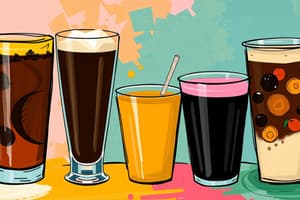Podcast
Questions and Answers
When pairing a beverage with a dish, which factor is MOST important to consider in order to achieve a harmonious taste?
When pairing a beverage with a dish, which factor is MOST important to consider in order to achieve a harmonious taste?
- The price of the beverage relative to the dish.
- The color of the beverage and the dish.
- The balance between the beverage and the food's characteristics. (correct)
- The geographic origin of the beverage and the dish.
Why do acidic beverages often pair well with rich or fatty foods?
Why do acidic beverages often pair well with rich or fatty foods?
- Acid enhances the sweetness of fatty foods.
- Acidity balances the richness and cleanses the palate. (correct)
- Acidic beverages increase the perception of saltiness.
- Acidity neutralizes the fat content in the food.
Which type of beverage would BEST complement a spicy dish?
Which type of beverage would BEST complement a spicy dish?
- A high-tannin red wine.
- A dry, acidic sparkling wine.
- A bitter, hoppy beer.
- A sweet or off-dry white wine. (correct)
What characteristic of red wine can be both beneficial and detrimental when pairing with food?
What characteristic of red wine can be both beneficial and detrimental when pairing with food?
If a nutty cheese is served, which of the following pairings would be considered a congruent pairing?
If a nutty cheese is served, which of the following pairings would be considered a congruent pairing?
Which of the following is NOT one of the key principles of food safety?
Which of the following is NOT one of the key principles of food safety?
Why is it important to use separate cutting boards for raw meats and vegetables?
Why is it important to use separate cutting boards for raw meats and vegetables?
At what temperature should perishable foods be refrigerated to prevent bacterial growth?
At what temperature should perishable foods be refrigerated to prevent bacterial growth?
Which of the following practices is MOST important for maintaining personal hygiene while handling food?
Which of the following practices is MOST important for maintaining personal hygiene while handling food?
What is the primary goal of implementing a Hazard Analysis and Critical Control Points (HACCP) system?
What is the primary goal of implementing a Hazard Analysis and Critical Control Points (HACCP) system?
Flashcards
Beverage Pairing
Beverage Pairing
Enhances dining by complementing or contrasting dish flavors, balancing characteristics for a harmonious taste.
Complementary Pairing
Complementary Pairing
Emphasizes similar flavors between beverage and food, creating harmony.
Contrasting Pairing
Contrasting Pairing
Balances different flavors between beverage and food, creating interest.
Cleaning (food safety)
Cleaning (food safety)
Signup and view all the flashcards
Separating (food safety)
Separating (food safety)
Signup and view all the flashcards
Cooking (food safety)
Cooking (food safety)
Signup and view all the flashcards
Chilling (food safety)
Chilling (food safety)
Signup and view all the flashcards
Biological Hazards
Biological Hazards
Signup and view all the flashcards
Chemical Hazards
Chemical Hazards
Signup and view all the flashcards
Physical Hazards
Physical Hazards
Signup and view all the flashcards
Study Notes
- Food and beverage broadly encompasses any substance consumed to provide nutritional support for the body
- Beverages are drinks, and the term encompasses a wide variety of liquids including water, soft drinks, juice, and alcoholic drinks
Beverage Pairings
- Beverage pairings enhance the dining experience by complementing or contrasting the flavors of a dish
- The goal is to find a beverage that balances the food's characteristics, creating a harmonious taste
- Factors to consider include flavor intensity, acidity, sweetness, tannins, and body
- Flavor intensity: Match the intensity of the beverage to the food
- Acidic beverages pair well with rich or fatty foods
- Sweetness in beverages can balance spicy or salty dishes
- Tannins, found in red wine, can cut through fatty foods but clash with spicy foods
- Body refers to the weight and texture of the beverage in the mouth
- Light-bodied beverages pair well with light dishes; full-bodied beverages pair well with heavy dishes
Types of Beverage Pairings
- Complementary pairings create harmony by emphasizing similar flavors
- Congruent pairing is a specific type of complementary pairing where the beverage and food share very similar flavor compounds (e.g. nutty cheese with nutty beer)
- Contrasting pairings create interest by balancing different flavors
- For example, sweet wine with salty cheese
- Astringent beverages, those high in tannins, pair well with fatty foods
- Acidic drinks help cleanse the palate between bites, especially with rich dishes
- Spicy foods benefit from beverages with sweetness to cool the palate
Temperature Considerations in Beverage Pairing
- The temperature of both the food and beverage affects their flavors
- Warmer temperatures can enhance sweetness and aroma
- Colder temperatures can emphasize crispness and acidity
- Serve beverages at their optimal temperature to enhance the pairing experience
- Red wine is typically served at (16-18°C)
- White wine and sparkling wine are served chilled (8-12°C)
- Beer serving temperatures vary widely depending on the style
Specific Food and Beverage Pairings
- Red meat pairs well with full-bodied red wines like Cabernet Sauvignon
- Poultry pairs well with medium-bodied white wines like Chardonnay or light-bodied red wines like Pinot Noir
- Fish pairs well with light-bodied white wines like Sauvignon Blanc or Pinot Grigio
- Shellfish pairs well with dry sparkling wines or crisp white wines
- Spicy foods pair well with sweet or off-dry white wines like Riesling or Gewürztraminer
- Salty foods pair well with acidic beverages or slightly sweet wines
- Cheeses pair well with a variety of beverages, depending on the cheese type
- Desserts pair well with sweet wines or fortified wines like Port or Sherry
- Chocolate pairs well with red wine, Port or Stout beer
Other Beverage Options
- Beer pairings are very diverse
- Light lagers pair well with salads or light appetizers
- India Pale Ales (IPAs) pair well with spicy foods
- Stouts and Porters pair well with chocolate desserts or grilled meats
- Cocktails are an excellent option as well
- Consider the base spirit, mixers, and garnishes when pairing
- Non-alcoholic beverages like iced tea, lemonade, or sparkling water can also provide excellent pairings
Food Safety
- Food safety involves handling, preparing, and storing food in a way that reduces the risk of individuals becoming sick from foodborne illnesses
- It is a scientific discipline describing handling, preparation, and storage of food in ways that prevent foodborne illness
- This includes a number of routines that should be followed to avoid potential health hazards
- Food safety standards and regulations are in place to protect consumers
Key Principles of Food Safety
- Cleaning: Thoroughly wash hands, surfaces, and equipment
- Separating: Prevent cross-contamination by keeping raw and cooked foods separate
- Cooking: Cook foods to safe internal temperatures to kill harmful bacteria
- Chilling: Refrigerate perishable foods promptly to prevent bacterial growth
Common Food Hazards
- Biological hazards include bacteria, viruses, parasites, and fungi
- Chemical hazards include toxins, pesticides, and cleaning agents
- Physical hazards include objects like glass, metal, or bone fragments
- Allergens: common allergens include peanuts, tree nuts, milk, eggs, soy, wheat, fish, and shellfish
Safe Food Handling Practices
- Wash hands thoroughly with soap and water for at least 20 seconds
- Use separate cutting boards and utensils for raw and cooked foods
- Cook foods to the recommended internal temperatures
- Use a food thermometer to ensure accurate cooking
- Refrigerate perishable foods within two hours or one hour if exposed to temperatures above 90°F (32°C)
- Thaw frozen foods in the refrigerator, in cold water, or in the microwave
- Avoid cross-contamination by storing raw meats on the bottom shelf of the refrigerator
- Wash fruits and vegetables thoroughly under running water
- Discard any food that looks or smells suspicious
Storage Guidelines
- Proper food storage is essential to prevent spoilage and bacterial growth
- Store foods at the correct temperature
- Refrigerate perishable foods at or below 40°F (4°C)
- Freeze foods at or below 0°F (-18°C)
- Use airtight containers to prevent freezer burn and contamination
- Label and date food items to ensure proper rotation
- Practice FIFO (First In, First Out) to use older items before newer ones
Preventing Foodborne Illness
- Foodborne illness, also known as food poisoning, is caused by consuming contaminated food or beverages
- Common symptoms include nausea, vomiting, diarrhea, and abdominal cramps
- Proper food handling and preparation can significantly reduce the risk of foodborne illness
Personal Hygiene for Food Handlers
- Maintain good personal hygiene to prevent contamination
- Wear clean clothing and aprons
- Tie back hair or wear a hairnet
- Avoid touching your face, hair, or mouth while handling food
- Cover cuts and wounds with bandages
- Avoid working with food if you are sick
- Do not smoke, chew gum, or eat while preparing food
Cleaning and Sanitizing
- Cleaning removes visible dirt and debris
- Sanitizing reduces the number of microorganisms to a safe level
- Use hot, soapy water to clean surfaces and equipment
- Sanitize surfaces with a chemical sanitizer, such as bleach or quaternary ammonium compounds
- Follow the manufacturer's instructions for proper concentration and contact time
Pest Control
- Pests can contaminate food and spread diseases
- Implement a pest control program to prevent infestations
- Seal cracks and openings to prevent pests from entering
- Store food in airtight containers
- Keep the kitchen clean and free of food debris
- Work with a professional pest control service if necessary
Importance of Food Safety Training
- Food safety training is essential for food handlers to learn proper techniques and procedures
- Training programs cover topics such as foodborne illness prevention, safe food handling, and cleaning and sanitizing
- Certification may be required for certain food handlers
Regulations and Standards
- Food safety regulations and standards are enforced by government agencies
- These regulations aim to protect consumers from foodborne illness
- Examples include HACCP (Hazard Analysis and Critical Control Points) and GMP (Good Manufacturing Practices)
Hazard Analysis and Critical Control Points (HACCP)
- HACCP is a systematic approach to identifying, evaluating, and controlling food safety hazards
- It involves analyzing the food production process to identify potential hazards
- Establishing critical control points (CCPs) to prevent or eliminate hazards
- Monitoring CCPs to ensure they are under control
- Taking corrective actions when deviations occur
- Verifying that the system is working effectively
- Maintaining records to document the system
Good Manufacturing Practices (GMP)
- GMPs are a set of guidelines that outline the minimum requirements for manufacturing processes
- They cover aspects such as facility design, equipment maintenance, and personnel training
- Following GMPs helps ensure that food products are safe and of high quality
Studying That Suits You
Use AI to generate personalized quizzes and flashcards to suit your learning preferences.




